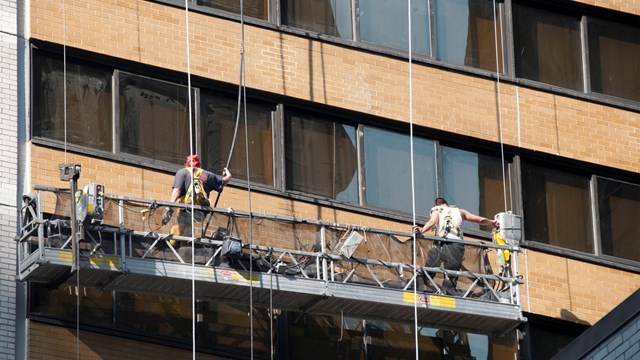
A snowy winter is a child's dream. What's more fun than the chance to build snowmen, dominate in snowball fights and of course, relish in the pure joy that is a snow day? Oh, to be young, blissful—and mostly ignorant of the havoc wreaked by major winter weather.
Plenty of adult New Yorkers are still trembling from the memory of the great 'Snowpocalypse' of 2010 (and a few notable doozies before and since), and they know better. Frosty the Snowman becomes a sinister sign of impending mayhem, especially for co-ops and condos, which are responsible for keeping residents safe from snow- and ice-related slips and falls.
Alvin Wasserman, the director of asset management for Fairfield Properties, a property management firm in Melville, knows this pressure and responsibility that comes with snow storms all too well.
“For children, the prospect of snow is exciting and inviting. For adults and homeowners, snow is often regarded with trepidation,” he says. “Condominiums and cooperatives can prepare several ways in the autumn for the possibility of snow.”
Removal Responsibility
Suffice to say, snow and ice are a multifaceted challenge—take the aforementioned Snowmageddon debacle for example. The event spanned well beyond the initial blizzard on December 26th, causing issues well into February, and was as relentless as it was damaging. As the snow just kept falling, alarm rose over where to put it all, and co-op and condo boards wondered what and about what exactly their responsibility was when it comes to removing snow and ice from their properties in a timely fashion.
The New York City Department of Sanitation (DSNY) handles snow removal for the city, and the department's commissioner is responsible for arranging removal of snow from city streets. Per the New York Administrative Code (LAW § 16-123 : NY Code - Section 16-123), commercial property owners are in charge of removing snow in front of their property, as well as the nearby sidewalks and parking lots. Unsurprisingly, private homeowners are also in charge of clearing snow in front of their respective properties. Same goes for cooperative corporations and condominium associations; they too are responsible for removing snow from all areas of their buildings and grounds.
New York City’s administrative code states that snow and ice must be cleared from sidewalks within four hours after a snow event. If an overnight snowfall should occur ('overnight being after 9 p.m.), the snow must be cleared by 11 a.m. Removed snow cannot be thrown into the street—it is illegal and could land the association a violation.
The administrative code further adds that “In case the snow and ice on the sidewalk shall be frozen so hard that it cannot be removed without injury to the pavement, the owner, lessee, tenant, occupant or other person having charge of any building or lot of ground as aforesaid, may, within the time specified in the preceding subdivision, cause the sidewalk abutting on such premises to be strewed with ashes, sand, sawdust, or some similar suitable material, and shall, as soon thereafter as the weather shall permit, thoroughly clean such sidewalks.”
A building can face fines (up to $350)—not to mention liability lawsuits that can easily run into the many thousands of dollars—if snow removal requirements aren't followed. Local requirements aside, the basic assumption throughout New York City is that it is the association’s responsibility to keep all areas safe. Associations therefore must have a game plan in place long before the need for snow-clearing arises.
“The law requires you to clean sidewalks within four hours of a snowstorm, but the truth of the matter is, we're usually out there a whole lot quicker trying to keep it from icing and removing the snow as soon as possible,” says Steven Birbach, chairman of Carlton Management in Glenwood Landing. “It's clearly a priority in the co-op managed buildings. You're also supposed to prevent icing as well, so it's your obligation to put down pellets.”
Depending on a building's staff, the size of its lot and the amount of snowfall, some board-management teams might choose to have staff members remove the snow, while others prefer to call in the professionals, Birbach says. If management delegates the work to the building staff, they need to make sure to provide their personnel with the right tools to do the job safely and thoroughly.
“We stay on top of the weather reports, so if we know a storm is coming in the evening, we alert our supers beforehand and make sure they have ample supply of salt pellets, shovels and the usual hardware to deal with the snowstorm,” Birbach says.
Jason Schwartz, owner and operator of NY SnowBuster, Inc., a snow removal company in Medford, New York, also recommends having a snow-blower on hand with at least five gallons of gas in tow to refuel.
Snow blowers and salt pellets aren't the only thing to worry about when it comes to removal, however. Birbach urges associations to leave room in the yearly budget for paying staff members overtime to clear snow, if need be. “If it's going to be snowing late into the evening, it could be a long night for them, and they might have to work overtime. That should also be put into a building's budget to allow for overtime for snow removal. Very often, it doesn't snow during 9-to-5; it snows on weekends and evenings when staff may not be on call. Additional pay would be necessary.”
Contract Options
In general, property management companies are responsible for contracting out seasonal upkeep work to landscaping and maintenance contractors, generally bidding the jobs out each year or so. Wasserman says there are two different ways a building board or an association can choose to contract out for snow removal, each coming with its own caveats.
“A contract that includes all eventualities will be the most expensive,” Wasserman says. A snow contract is like an insurance policy. If it is all-inclusive, the contractor must be prepared to meet the worst possible conditions. He also is in business to earn a profit that will be added on to the cost of a worst case scenario. The advantage to a building or association with this type of contract is they know how their budget will be affected, irrespective of weather conditions. The disadvantage is there will be years when they overpay for this kind of protection,” he says.
“As an example,” Wasserman continues, “in one year a property paid $4,000 for snow removal on a per diem basis. The winter was mild with minimal snowfall. The prior year,” he continues, “there were numerous storms. The board decided to purchase a snow contract that cost over $20,000. With a severe winter, the owners come out ahead. In a mild winter, the snow contract will be like an insurance policy with only minor claims placed against it.”
Schwartz recommends taking lot size into consideration when deciding on what kind of contract to go with.
“For lots under three acres, it's good to have a per event plow price, which are usually priced per inch of snow,” Schwartz says. For lots over five acres, I've found it's much better for owners to have an hourly contract. So, for example, if you get a large snowfall, you pay by the hour and a man is on-site plowing or snow blowing,” he says.
Methods
Snow removal experts use a variety of methods and equipment to keep property safe for businesses and condominiums. The most basic snow-cleaning tool, after the shovel and plow, is, of course, chemical ice melt. The oldest (and cheapest) variety, commonly known as 'rock salt' is actually calcium chlorate, which is effective at melting ice—but unfortunately it also essentially melts concrete, penetrating into the pores of pavement, heating up and splitting it apart. Use of calcium chlorate during the winter means frequent restorative maintenance during the other three seasons of the year.
Within the last two years, a liquid version of the calcium chloride mixture has been developed for use on city streets. It is green in color and works better than rock salt, without the damaging salt and sand that characterized its predecessor.
Other, more expensive (at least initially), options for snow removal are heated sidewalks and driveways, and the permeable paver system. Both of these systems are expensive to install, and heated sidewalks—which rely on radiant electric heat to melt snow and ice—require a steady supply of electricity to run them, but both get the job done in a way that scattered salt just doesn't.
The permeable paver system is not a method for snow maintenance in an entire community but could be a solution in problem areas, especially where there is a likely accumulation of water from melting snow which may then refreeze. This system works by excavating a dry well that is deeper than the geothermal frost line, in the area to be paved. The well is filled with layers of stones decreasing in size as they reach the surface, and then paving slabs are laid on top. This system creates good drainage for the wet area and utilizes the constant 54 degree (F) temperature of the earth below the frostline to help keep ice from forming.
Regardless of new paving and ice melting technologies, however, the likelihood of a crew needing to come out and shovel or plow or snow-blow at least some portion of a property is likely, thanks to our area's susceptibility to nor'easters. Unless the property also contains its own snow field for holding snow waste, contractors will need to remove the piles of plowed and shoveled snow off the property, too, to prevent them from melting into walks and driveways and refreezing.
Constant clearing is so necessary that experts say contractors must have special insurance, and sometimes crews will stay on a site over 24 hours—for example, during a blizzard—simply to make sure entryways, exits, walkways and driveways are cleared at least hourly. This is an option NY Snow Buster provides.
“The way we deal with a lot of facilities is we give them what they call a stationary crew, where they call up—we have a three hour response time—and the truck is on the property for the duration of the [snow] event plowing,” Schwartz says. “This way, associations know that there is an on-site crew that will be removing the snow as it builds, versus coming at 2 a.m. when the snow stops and now it's still not plowed by the next morning. If you work the storm properly and you're there from the beginning to the end of the storm, in most cases, the owner saves money because they don't have to cart the snow away and get payloaders in to remove the snow. If you're continually plowing every two inches, it won't get to a point where it can't be moved,” he says.
Hiring Wisely
With the potential of a debilitating liability lawsuit hanging over their heads, building boards and associations do not want to skimp on quality snow removal. Schwartz suggests associations avoid hiring a local handyman or group of neighborhood kids for the job and sticking to the specialists—landscapers, engineers, and professional removal experts—to guarantee quality work.
“We're a seasonal business, we're not a landscaper,” Schwartz says. “I found it's better to work with a company whose sole source of revenue and profession is snow removal. When a company does snow removal and [a bunch of other things], that tells you something. In most cases what they're doing is just throwing a plow on one of their trucks. All of our trucks are strictly used for plowing.”
With the proper tools and crew in tow, making it through the harsh winter without any slips or falls is doable. Surviving the cruel wind chill without frostbite? Well, that's another story.
Jennifer Grosser is a Massachusetts-based freelance writer. Editorial Assistant Enjolie Esteve contributed to this article.






Leave a Comment